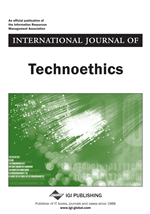 Sammanfattning av vetenskaplig uppsats. Robotteknologier är konstruerade system som interagerar med sin omgivning på ett sätt som visar en viss grad av handlingsfrihet. Tekniken blir alltmer sammanflätad med människans liv och den mänskliga kroppen även kallad transhumanism.
Sammanfattning av vetenskaplig uppsats. Robotteknologier är konstruerade system som interagerar med sin omgivning på ett sätt som visar en viss grad av handlingsfrihet. Tekniken blir alltmer sammanflätad med människans liv och den mänskliga kroppen även kallad transhumanism.
Sammanfattning: Michael Eleman
Beställ hela artikeln på igi-global.com för 37, 50 USD
Robotteknologier väcker många regulatoriska frågor, eftersom nuvarande rättsliga ramar har få robotspecifika bestämmelser och robotteknologier innebär nya utmaningar för rättsliga begrepp. Som hjälp för reglering av robotteknologier bör tas hänsyn tas till de grundläggande mänskliga rättigheterna. Dock är den konstitutionella ramen för de grundläggande mänskliga rättigheterna inte immuna mot att påverkas av robotteknologier.
Denna uppsats diskuterar hur skyddet av de grundläggande mänskliga rättigheterna påverkas av robotteknologier, med hänsyn till de politiska och grundläggande mänskliga rättigheterna, reglering samt teknik.
Efter en allmän översikt över hur de grundläggande rättigheterna utmanas av robotteknologierna, zoomar författarna in på tre specifika tillämpningsområden:
- industrirobotik och frågan om arbetstagarnas rättigheter och ansvar,
- hjälpmedel med fokus på autonomi och integritet för äldre och funktionshindrade, och
- biomedicinsk robotteknik ( inklusive hjärna-dator-interaktion ) i relation till informerat samtycke och självbestämmande.
Analysen belyser olika konsekvenser av robotteknologier i ljuset av grundläggande mänskliga rättigheter och värderingar, vilket tyder på att tillsynsmyndigheterna kommer att ha att göra med rättigheter och värdekonflikter som uppstår med robotutvecklingen.
För att bidra till att lösa dessa konflikter, kan en uppsättning gemensamma normer, standarder och riktlinjer tas fram, i form av ickebindande regler, som kan fungera som en bro för att urskilja grundläggande mänskliga rättigheter och konkret praxis för robotteknologier.
Robotic Technologies And Fundamental Rights: A European Union Perspective
The role played by new technologies in contemporary society has significantly increased over the last decades. Technology is now an essential part of everyday life; it even increasingly is becoming an integrated part of the human body, as people not only use clothes and glasses but also implants and bionic devices. Since technology is neither good nor bad, nor is it neutral (Kranzberg, 1986), technology must be subjected to moral and social controls (Bunge, 1977, p. 106). This makes technoethics an important field of scholarship, which is defined as “the branch of ethics that investigates the moral issues encountered by technologists and by the public at large in connection with the social impact of large-scale technological projects” (Bunge, 1979, p. 70). Technoethics is concerned with “critical debates on the responsible use of technology for advancing human interests in society” and thereby “help guide ethical problem-solving and decision making in areas of activity that rely on technology” (Luppicini, 2009, p. 4).
Ethical questions of morality and ethical problem-solving closely relate to other fields of decision-making, not the least to legislative decisions. A key element in ensuring the responsible use of technology for advancing human interests are human rights, which perform a crucial task in “preventing the wrong” that is one of the concerns of ethics (Griffin, 2008, p. 19). Ever since Locke’s Two Treatises of Civil Government, human rights have functioned as “moral constraints on the arbitrary acts of rulers” (Griffin, 2008, p. 11). Although naturalistic accounts of how human rights come into existence have largely given way to procedural, contract-theory accounts (e.g., Dworkin, 1977), recent attempts try to re-introduce a more substantive account of what constitute ‘human’ rights, by conceiving of them as protecting the normative agency of humans (Griffin, 2008).
Interestingly, it is precisely the notion of (normative) agency that is also being affected by technology, through the rise of technologies that display some level of agency themselves: robotics. Thus, from a technoethical perspective focusing on responsible use of technology, robotics raise questions not only about how the protective function of human rights plays out in a robotics-pervaded world, but also how robotics affect the interpretation of human rights itself. In that light, it makes sense not to speak of ‘human’ rights but rather of ‘fundamental’ rights, i.e., basic rights pertaining to entities with (moral) agency to protect their functioning in society?which may apply not only to humans but also to legal persons and, perhaps in some future, to machines or man-machine combinations that are capable of moral reasoning. Using the term ‘fundamental rights’ is also in line with the way in which these basic rights are currently being shaped in law. Against this background, this paper aims at discussing the protection of fundamental rights in contemporary technology-pervaded society. We will adopt a European Union perspective, because the EU’s dual aim of fostering an innovation-friendly internal market as well as an area of freedom, security, and justice makes the regulation of robotics particularly salient in this jurisdiction.
After an introduction into EU fundamental rights and robotics, we discuss how fundamental rights are challenged by robotic technologies. We then take into consideration three particular fields of robotic applications to highlight some relevant legal issues. As the analysis highlights that conflicts may arise in the protection of fundamental rights, we end with identifying some ways to handle conflicts in the European constitutional framework.
Relaterat
IBM: Five in Five—where are they now?
”Sex, money and health”* concluded our Summit – brilliantly presented by Professor Hans Rosling. His global scope perfectly set the stage for next year’s special focus on emerging markets. The convergence of information, Internet, and wireless with healthcare technologies is also breaking borders and attracting new innovative players. SALSS 2012 has the ambition to once again be a platform of change and be ’global, but personal’ just as the industry itself. See you then!
Barbro C. Ehnbom, Chairman, Swedish-American Life Science Summit”

 NewsVoice är en oberoende nättidning med utgivningsbevis som startade 2011. Syftet är att publicera nyheter, debattartiklar, kommentarer och analyser.
NewsVoice är en oberoende nättidning med utgivningsbevis som startade 2011. Syftet är att publicera nyheter, debattartiklar, kommentarer och analyser. 